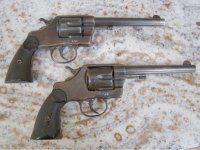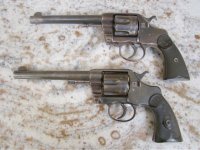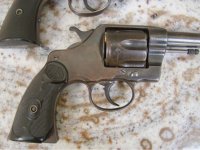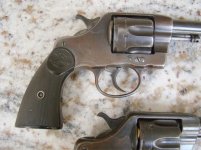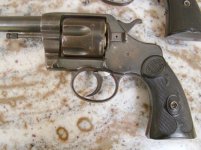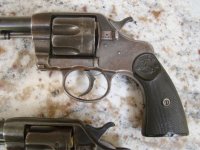You are using an out of date browser. It may not display this or other websites correctly.
You should upgrade or use an alternative browser.
You should upgrade or use an alternative browser.
Educate me on Colt 1892, 1894, 1895, etc.
- Thread starter finloq
- Start date
Not an easy subject, and a lot of confusion. First, the Model year designations were used by the Army and Navy but with the exception of the "1892" and the rare "1894" grip markings on the New Army, Colt did not apply them to civilian guns, which were called simply the "New Army" or "New Navy". Generally, changes made at the request of the services were applied to civilian models at about the same time. Civilian guns were made in both .38 Long Colt and .41; military guns were made only in .38.
Both Army and Navy contract revolvers had butt markings indicating government ownership; civilian guns had only the serial number on the butt, usually in two lines. Army contract guns had plain wood stocks, marked with inspectors' initials. Navy contract guns had hard rubber grips with the word "COLT" in an oval a the top, as did the grips on civilian New Navy guns. Civilian New Army guns also had hard rubber grips, but with a prancing Colt; early guns had the date "1892" on them and some later had "1894" but the date was then dropped and not used again. In civilian sales, the grips were the only difference between the two models.
As to the difference between the Model 1894 and the Model 1896 (Army designations), there is a lot of dispute. Robert Best (A Study of Colt's New Army and New Navy Pattern Double Action Revolvers 1889 to 1908), says he is unable to find any difference and thinks the model number change might have been for contract purposes.
But there are some oddities about that lower gun. First, the grips look like Army Special grips, c. 1908. The ejector rod head is also late, and I don't think it is original to a New Navy revolver. But the grip shape (like the old SAA) and the grip "hump" look like an early New Navy (Model 1889). Could that gun be a conversion? That would explain the different appearance of the sideplate as its replacement was part of the conversion.
Full serial numbers would be a help (x out the last two if you must), as would the last patent date from the barrel.
Jim
Both Army and Navy contract revolvers had butt markings indicating government ownership; civilian guns had only the serial number on the butt, usually in two lines. Army contract guns had plain wood stocks, marked with inspectors' initials. Navy contract guns had hard rubber grips with the word "COLT" in an oval a the top, as did the grips on civilian New Navy guns. Civilian New Army guns also had hard rubber grips, but with a prancing Colt; early guns had the date "1892" on them and some later had "1894" but the date was then dropped and not used again. In civilian sales, the grips were the only difference between the two models.
As to the difference between the Model 1894 and the Model 1896 (Army designations), there is a lot of dispute. Robert Best (A Study of Colt's New Army and New Navy Pattern Double Action Revolvers 1889 to 1908), says he is unable to find any difference and thinks the model number change might have been for contract purposes.
But there are some oddities about that lower gun. First, the grips look like Army Special grips, c. 1908. The ejector rod head is also late, and I don't think it is original to a New Navy revolver. But the grip shape (like the old SAA) and the grip "hump" look like an early New Navy (Model 1889). Could that gun be a conversion? That would explain the different appearance of the sideplate as its replacement was part of the conversion.
Full serial numbers would be a help (x out the last two if you must), as would the last patent date from the barrel.
Jim
Yep, that lower gun started out as a New Navy, Model 1889, probably made in late 1891. It was a civilian gun. It had no cylinder notches or leades, with the cylinder being locked from the back by the hand, like the Model 1878 DA Army. A chronic problem with those guns was that they would "back up", with the cylinder being dragged backward by the hand when the trigger was released. Obviously, that could be a danger, as the shooter could keep trying to fire the same fired cartridge over again.
In 1895, the Navy contracted Colt to bring the old models up to the (Navy) Model 1895 standards with new cylinders and other parts; I have not seen a reference to a similar conversion done on civilian guns, but I have no reason to doubt it would have been done if someone sent the gun (and money) to Colt.
Part of the conversion contract with the Navy was that Colt would replace any barrels that were unserviceable; that would probably have been done with civilian guns also. The replacement barrels have the 1895 patent date, which is why you thought the gun was made later than it was.
Incidentally, I suspect the grip on your revolver was broken off at the lower front to conceal the fact that it did not fit that frame. Are both grips broken in a similar manner?
Jim
In 1895, the Navy contracted Colt to bring the old models up to the (Navy) Model 1895 standards with new cylinders and other parts; I have not seen a reference to a similar conversion done on civilian guns, but I have no reason to doubt it would have been done if someone sent the gun (and money) to Colt.
Part of the conversion contract with the Navy was that Colt would replace any barrels that were unserviceable; that would probably have been done with civilian guns also. The replacement barrels have the 1895 patent date, which is why you thought the gun was made later than it was.
Incidentally, I suspect the grip on your revolver was broken off at the lower front to conceal the fact that it did not fit that frame. Are both grips broken in a similar manner?
Jim
Jim, if I could impose? Could you educate me on the grips. My plan was to get a repro replacement set for occasional shooting (for my older boys, I usually put 10-20 rounds down them and then clean/oil them and into the back of the safe they go). There are a few Colt 1894 repro sets available on eBay right now. Are you stating that because of the older frame style, these would use the SAA style grips instead?
Last edited:
spacecoast
New member
Before shooting, make sure you do NOT try to use .38 special, it may fit but it's too strong for the gun. Also check the timing and lockup of the cylinder, if there is significant wiggle (as is the case with most of these guns) you are asking for trouble.
Below is a pic of the grip from my 1892 (mfd. 1894). The gun's not shootable in present condition due to timing and lockup problems.
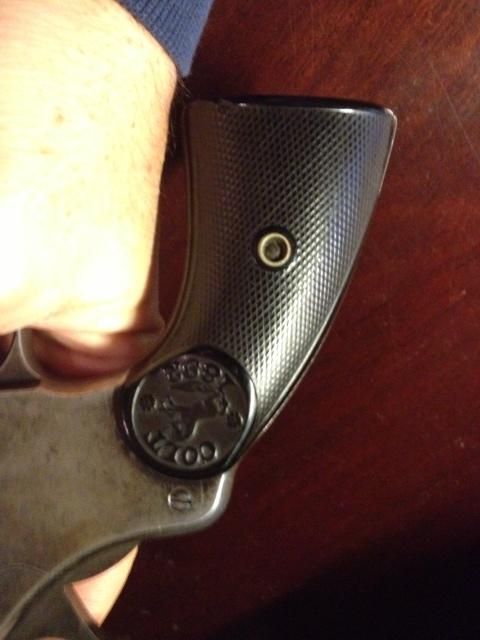
Below is a pic of the grip from my 1892 (mfd. 1894). The gun's not shootable in present condition due to timing and lockup problems.

You can see for yourself that the grips of the two guns are not the same. As you say, the grips for the 1892, etc. are available. I have used grips from this company and found they are OK and good repros. Further, they are plastic rather than hard rubber and won't break or chip. Here is the page with the 1892/94 grips:
http://www.gungrip.com/items_22__page2.html
But they don't list the Model 1889, probably due to lack of demand since the gun had low production.
I don't know where those grips came from on the 1889. My best guess is that the gun was updated around 1908, and the Colt factory put on grips of the style then current, along with that type ejector rod head.
Gun Parts Corp has some parts for those guns, but they are scarce. The mechanism is unlike any other Colts, either before or after them. Common problems are broken hand and cylinder lock spring; they can be made but are not usually available.
Hi, Spacecoast,
FWIW, after about s/n 200,000 and with the Army Model 1903, Colt began to bore the chambers all the way through for use with the .38 Special. The usual advice about the guns not being strong enough does not appear to be correct, as the cylinder is the same diameter and material as that of the Army Special, which was made for the .38 Special. Those late guns, though, will chamber .357 Magnum, and that is definitely not to be fired in them. Of course, the .38 Special is the loading of the day, the standard 158 gr roundnose bullet, not +P or +P+ loads.
Jim
http://www.gungrip.com/items_22__page2.html
But they don't list the Model 1889, probably due to lack of demand since the gun had low production.
I don't know where those grips came from on the 1889. My best guess is that the gun was updated around 1908, and the Colt factory put on grips of the style then current, along with that type ejector rod head.
Gun Parts Corp has some parts for those guns, but they are scarce. The mechanism is unlike any other Colts, either before or after them. Common problems are broken hand and cylinder lock spring; they can be made but are not usually available.
Hi, Spacecoast,
FWIW, after about s/n 200,000 and with the Army Model 1903, Colt began to bore the chambers all the way through for use with the .38 Special. The usual advice about the guns not being strong enough does not appear to be correct, as the cylinder is the same diameter and material as that of the Army Special, which was made for the .38 Special. Those late guns, though, will chamber .357 Magnum, and that is definitely not to be fired in them. Of course, the .38 Special is the loading of the day, the standard 158 gr roundnose bullet, not +P or +P+ loads.
Jim
Last edited:
Best shows the civilian model 1889 made into 1895, alongside the 1892 model, with the last serial number being 34497. It seems that the frame was changed on the later models and the Felton lock* added, but the other lockwork was unchanged and the cylinder is still locked by the hand.
*The Felton lock kept the gun from being cocked when the cylinder was not locked in place.
Edited to add: There are two final serial numbers cited in Best's book, 33497 and 34497. One is obviously a typo; based on the number of cites, I think the former is probably correct, if it makes any difference to anyone.
Jim
*The Felton lock kept the gun from being cocked when the cylinder was not locked in place.
Edited to add: There are two final serial numbers cited in Best's book, 33497 and 34497. One is obviously a typo; based on the number of cites, I think the former is probably correct, if it makes any difference to anyone.
Jim
Last edited:
It is too bad in a way that your gun was updated; nice 1889's are scarce and highly collectible, as the first Colt swing cylinder revolvers. Yet you also have an updated civilian model and there weren't many. Of course, collectors being what they are, the military models bring more money. Still, those guns are in sort of a limbo; they should be highly collectible, guns used in a war that made the U.S. a world power, yet they sell for relatively little compared with the SAA or even the 1877 or 1878 models.
The gun that succeeded them, the .45 Model 1909 revolver is also something of a forgotten gun. Most gun folks believe that the .38 revolvers were followed by the 1911 auto pistol, but that is not true.
Jim
The gun that succeeded them, the .45 Model 1909 revolver is also something of a forgotten gun. Most gun folks believe that the .38 revolvers were followed by the 1911 auto pistol, but that is not true.
Jim
Jim, the ejector rod head appears to be from a Colt New Model. Do you know when Colt switched to that style? It would appear from your earlier post that it was sometime after 1908?
I am assuming that it was replaced by an owner, but a close up does show some corrosion on the left side consistent with the rod itself, so I am assuming that it has been there for several decades at least.
I am assuming that it was replaced by an owner, but a close up does show some corrosion on the left side consistent with the rod itself, so I am assuming that it has been there for several decades at least.
Last edited:

